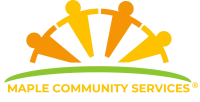Muscular Dystrophy and physical activity
The journey of those living with muscular dystrophy unfolds with a unique set of trials and triumphs. Amidst the complexities of this condition, the transformative power of thoughtful physical activity offers a symbiotic relationship, providing a catalyst for empowerment and improved quality of life.
Exercise can ease muscular dystrophy symptoms through a tailored plan crafted by your healthcare team, including your physical therapist. Physical activities such as low impact aerobics, strength training, balancing and coordination exercises and adaptive sports can be considered to maintain joint flexibility and strengthen supporting muscles.
At Maple Community Services we want our clients to live the quality of life they deserve. Physical activity can be a powerful ally in the midst of the challenges faced by those living with muscular dystrophy. With the help of your support worker you can learn about the adaptive exercises that can help you to maintain mobility, prevent complications and enhance your overall well-being.
Can physical activity help muscular dystrophy?
Muscular dystrophy is a group of genetic disorders that are characterised by progressive weakness and degeneration. Although controversial, muscular dystrophy and exercise has proven to be highly beneficial, just as long as you approach your exercises with caution and under the guidance of your healthcare professionals.
Physical activity can offer several benefits for some people living with muscular dystrophy:
- Maintaining joint flexibility – gentle exercises and stretching can help to maintain your joint flexibility and prevent contractures, (the permanent shortening of muscles and tendons).
- Strengthening supporting muscles – strengthening exercises for your muscles that are not affected by dystrophy can help support your weakened muscles and improve your overall function.
- Cardiovascular health – low impact cardiovascular exercises, such as swimming or cycling, can promote your cardiovascular health without putting excess strain on your weakened muscles.
- Psychological benefits – regular physical activity can help to improve your mood, reduce stress and enhance your overall well-being.
If you are considering taking up or continuing physical activity with a muscular dystrophy diagnosis, it’s essential to note that not all types of exercise will be suitable and you should carefully monitor the intensity and duration of your activities. Different types of muscular dystrophy may require different approaches to exercise and there is no one-size-fits-all approach.
At Maple, we emphasise the importance of consulting with your healthcare team, including your physicians and physical therapists, to develop a personalised plan that considers your unique condition, your physical abilities and your limitations. In some cases assisted devices or adaptive equipment can be recommended for you to facilitate safe and effective exercises for muscular dystrophy.
How does muscular dystrophy affect physical activity?
Muscular dystrophy can certainly have a profound impact on your physical activity, as it systemically erodes the integrity and strength of your skeletal muscles. This group of genetic disorders manifests as progressive muscle degeneration, leaving those affected grappling with various degrees of weakness. The onset and severity of symptoms can present differently among the different types, but a common thread is the undermining of muscle function, making routine physical activities increasingly arduous.
Muscle weakness, a hallmark feature of MD, can impair your ability to perform tasks that require strength, such as standing, walking or lifting objects. As the disease advances, fatigue usually sets in more rapidly during physical exertion, which compounds the challenges you may face while trying to maintain an active lifestyle.
Muscle weakness is not the only characteristic of MD that affects physical activity:
- Joint contractures limit the range of motion in joints, which hinders fluid movements.
- Balance and coordination are compromised as the disease targets muscles responsible for stability.
- Respiratory muscles may also be affected in certain forms of MD, which contributes to breathing difficulties, particularly during activities that require increased oxygen intake.
The progressive nature of MD further exacerbates these challenges. However, with the help of adaptive strategies, and a tailored approach, your physical activity can be managed to benefit you effectively as your condition evolves over time.
What activities are good for muscular dystrophy?
Certain types of exercise are more beneficial than others for those living with muscular dystrophy. Your healthcare team alongside your support worker can help you to determine the best exercise routines for your unique situation and continue to tailor your plan as your condition progresses. Some exercise options to consider include:
- Low impact aerobic exercises – activities such as swimming, water aerobics, and stationary cycling can provide cardiovascular benefits without putting excessive strain on weakened muscles. Water based exercises, in particular, reduce the impact on joints and facilitate movement.
- Range of motion exercises – gentle stretching and range of motion exercises help to maintain joint flexibility and prevent contractures. These activities can be performed regularly to promote mobility and reduce stiffness.
- Strengthening exercises – targeting muscles that are not severely affected by the dystrophy can help to maintain strength and provide support to weakened muscles. Stretching exercises for muscular dystrophy such as resistance training exercises with light weights or resistance bands, under the guidance of a professional, can be beneficial.
- Balance and coordination training – exercises that focus on improving your balance and coordination can be helpful. They may include specific balance exercises, practising controlled movements and using assistive devices as and when needed.
- Assistive devices – depending on your needs and capabilities, assistive devices such as braces, orthotics, or mobility aids can be recommended to facilitate safe movement when participating in your physical activities.
- Adaptive sports – Some people who live with muscular dystrophy may be able to participate in adaptive sports tailored to their abilities. Adaptive sports, such as wheelchair basketball, adaptive cycling, or seated aerobics, help to provide opportunities to engage in physical activity as well as offering social engagement.
- Breathing exercises – these can be beneficial for those who are likely to experience respiratory problems. They can help with improving lung function and respiratory endurance.
- Physical therapy – regular sessions with a physical therapist is essential for those with MD. They can help you to design a personalised exercise program, provide guidance on proper techniques and monitor your progress as well as adjusting your plan as needed.
How can a support worker help with physical activity?
Maple offers a wide range of support services from CALD support to specialised support. Our Support Workers can assess your personal circumstances and discuss your preferences with you to find the ultimate physical activity routine to suit your evolving needs.
Maple Services takes great pride in its strategic partnerships with Athletics NSW and various local community sporting organisations, which have become a cornerstone of its commitment to fostering education and creating opportunities for the disabled community across Australia.
Through these collaborations, Maple Services extends its reach beyond traditional community services, empowering individuals with disabilities through tailored physical activity programs and inclusive sports environments.
By offering a platform for education, engagement, and skill development, Maple Services’ partnerships epitomise its dedication to enhancing the lives of those it serves. This is just another reason as to why people choose Maple for their Community Services needs.




